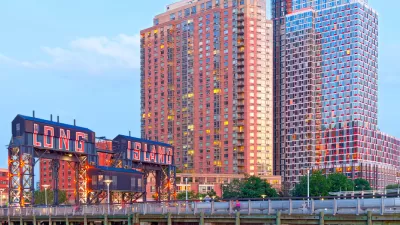New York City's population is expected to grow by one million residents by 2040. But where can housing be built to accommodate all these new residents? A new report from a Columbia University think tank identifies the most promising candidates.
Laura Kusisto looks at the findings of a new report [PDF] from Columbia University's Center for Urban Real Estate, which recommends the "most logical location for all this new housing: the city's waterfront neighborhoods, including Long Island City and Willets Point in Queens, Red Hook in Brooklyn and the Financial District..."
These recommendations, which "would pack more people into smaller areas than the Bloomberg administration has planned," raise some key questions about improvements that will need to be made to the city's existing infrastructure to accomodate such growth and address the city's growing inequity.
"Whether residents want more apartments in their neighborhoods remains to be seen," notes Kusisto. "In places such as Williamsburg where Bloomberg administration rezonings brought new residents, the result has been subway cars so packed that commuters wait for several trains to pass, lengthy kindergarten wait lists and promised parks that have yet to be delivered. The city has also yet to master the art of making tightly packed blocks of new glass towers feel like neighborhoods, rather than sterile enclaves."
Furthermore, focusing development along the waterfront, "raises serious questions after superstorm Sandy, when residents in Lower Manhattan, Long Island City and Red Hook were out of their homes for weeks or months."
FULL STORY: City's Boom Spurs a Need for Housing

Alabama: Trump Terminates Settlements for Black Communities Harmed By Raw Sewage
Trump deemed the landmark civil rights agreement “illegal DEI and environmental justice policy.”

Study: Maui’s Plan to Convert Vacation Rentals to Long-Term Housing Could Cause Nearly $1 Billion Economic Loss
The plan would reduce visitor accommodation by 25% resulting in 1,900 jobs lost.

Why Should We Subsidize Public Transportation?
Many public transit agencies face financial stress due to rising costs, declining fare revenue, and declining subsidies. Transit advocates must provide a strong business case for increasing public transit funding.

Paris Bike Boom Leads to Steep Drop in Air Pollution
The French city’s air quality has improved dramatically in the past 20 years, coinciding with a growth in cycling.

Why Housing Costs More to Build in California Than in Texas
Hard costs like labor and materials combined with ‘soft’ costs such as permitting make building in the San Francisco Bay Area almost three times as costly as in Texas cities.

San Diego County Sees a Rise in Urban Coyotes
San Diego County experiences a rise in urban coyotes, as sightings become prevalent throughout its urban neighbourhoods and surrounding areas.
Urban Design for Planners 1: Software Tools
This six-course series explores essential urban design concepts using open source software and equips planners with the tools they need to participate fully in the urban design process.
Planning for Universal Design
Learn the tools for implementing Universal Design in planning regulations.
Smith Gee Studio
Alamo Area Metropolitan Planning Organization
City of Santa Clarita
Institute for Housing and Urban Development Studies (IHS)
City of Grandview
Harvard GSD Executive Education
Toledo-Lucas County Plan Commissions
Salt Lake City
NYU Wagner Graduate School of Public Service





























